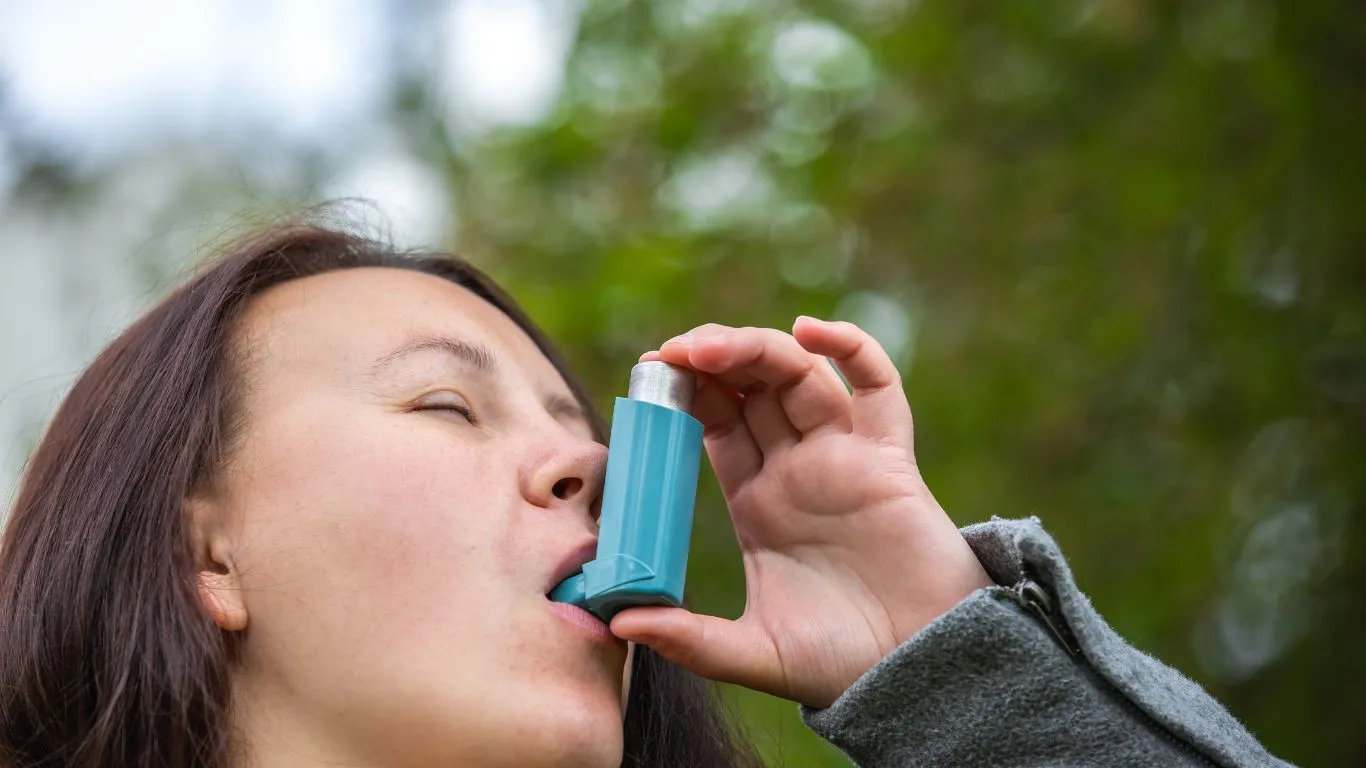How to Prevent Asthma Attacks During Cold Weather Effectively
As a pulmonary nurse, I’ve seen firsthand the challenges that individuals with asthma face, particularly during colder months. Cold weather can be a huge trigger for asthma attacks, and as someone who works closely with patients, I understand how frustrating it can be to manage asthma when the temperatures drop. If you’re one of the millions of people who experience asthma, you may find yourself wondering, “How can I prevent asthma attacks during cold weather?”
In this article, we’ll dive into practical tips and strategies to help you protect your lungs and avoid those uncomfortable, often scary, asthma flare-ups. From understanding the science behind cold-weather asthma triggers to simple actions you can take every day, this guide is here to help you breathe easy all winter long.
Why Cold Weather Affects Asthma

Cold weather can wreak havoc on your respiratory system, especially if you have asthma. When the air is chilly and dry, it can cause your airways to tighten, leading to increased inflammation and difficulty breathing. It’s important to understand why this happens. In cold weather, the cold air can trigger a series of reactions in the body, particularly in the lungs. The cold air causes the blood vessels in your airways to constrict, which can lead to an increase in airway resistance. This makes it harder to breathe and can potentially cause an asthma attack.
Moreover, cold air often lacks the moisture that warmer air has, which can dry out your airways, further irritating them. This is why it’s essential to protect your lungs when heading out into the cold. With the right precautions, you can minimize these risks and keep asthma attacks at bay during the chillier months.
How to Prevent Asthma Attacks During Cold Weather

As someone who works closely with people living with asthma, I can tell you that prevention is key. There are several steps you can take to manage your asthma and prevent attacks during cold weather. Some of these may be simple lifestyle changes, while others might involve adjustments to your routine or the way you approach the colder months. Let’s break down these steps so you can breathe more easily this winter.
1. Wear a Scarf or Mask
One of the simplest and most effective ways to prevent cold air from triggering your asthma is to cover your mouth and nose when you go outside. A scarf or a specially designed face mask can help trap moisture and warm up the air before it enters your lungs. This reduces the risk of airway irritation that can lead to asthma symptoms or even an attack. I always tell my patients that a scarf can be your best friend when you’re braving the cold!
2. Keep Your Home Warm and Humidified

Inside your home, it’s just as important to manage the environment to prevent asthma flare-ups. Cold, dry air indoors can also aggravate asthma symptoms. Consider using a humidifier in your home, especially in the bedroom while you sleep. A humidifier adds moisture to the air, which helps to keep your airways from becoming dry and irritated. If you don’t have a humidifier, taking a warm shower or bath can also add moisture to the air and soothe your respiratory system.
3. Stay on Top of Your Medications
Whether it’s a controller medication or a rescue inhaler, staying consistent with your prescribed asthma medication is crucial, particularly during the winter months. If you’ve noticed that cold weather exacerbates your asthma, make sure you have your inhaler with you when you step outside. Additionally, talk to your doctor about adjusting your medication regimen if necessary, as they may suggest preventive medications that can help minimize the risk of an asthma attack.
4. Limit Outdoor Activities During Extreme Cold
When the weather is particularly harsh, it’s best to limit your exposure to the cold air. I know this can be difficult, especially if you’re someone who loves outdoor activities, but it’s important to prioritize your health. If you do decide to venture out, try to do so when the temperatures are milder, such as mid-afternoon when the sun has warmed the air a bit. And remember, it’s always okay to stay indoors if the cold air feels too harsh.
5. Monitor Air Quality
Another factor that plays a huge role in asthma management is air quality. Cold weather often comes with increased pollution levels, including smog and other allergens that can trigger asthma symptoms. Keep an eye on your local air quality index (AQI) and avoid going outside on days when pollution levels are high. On days with poor air quality, staying indoors is your safest bet.
Other Environmental Triggers to Watch Out For
While cold air is a big asthma trigger, it’s not the only environmental factor that can cause flare-ups. There are other things in your surroundings that could irritate your airways, especially during the colder months. Be mindful of these other triggers and take action to reduce your exposure.
1. Dust and Mold
Indoor allergens, such as dust and mold, thrive in colder months when windows are kept closed and ventilation is limited. If you’re prone to asthma, it’s essential to keep your living spaces clean and free of dust. Regularly wash your bedding and vacuum your floors, especially if you have carpeting. Consider using allergen-proof pillowcases and mattress covers to reduce exposure to dust mites, which are another common asthma trigger.
2. Smoke and Fumes
During the winter, many people tend to use space heaters, wood stoves, and fireplaces. While these may keep you warm, they can also release irritants into the air. If you have asthma, try to limit exposure to smoke and fumes, as they can trigger an attack. Make sure your heating system is well-maintained, and if you’re using a fireplace or wood stove, ensure proper ventilation to avoid the buildup of harmful particles in the air.
By taking steps to control your environment and manage your asthma proactively, you can significantly reduce the likelihood of experiencing an attack during the cold weather months. It’s all about being prepared, staying aware of potential triggers, and using simple strategies to protect your lungs and keep yourself safe.
Understanding the Link Between Asthma and Cold Weather

As we dive deeper into how cold weather can affect asthma, it’s essential to understand the specific mechanisms at play. Cold air isn’t just uncomfortable—it can actually cause your airways to constrict, which is a common trigger for asthma symptoms. I’ve worked with many patients who feel a tightness in their chest as soon as they step into the cold. This tightening is your body’s reaction to the cold air, and it can make it harder to breathe, leading to asthma attacks if not properly managed. When the air you breathe is chilled, the body reacts by trying to protect itself from the cold, but in doing so, it can worsen asthma symptoms, such as wheezing, shortness of breath, and chest tightness.
Cold air can also dry out the moisture in your airways. Normally, when you breathe in warmer, humid air, your lungs have the benefit of extra moisture that helps prevent irritation. But in the cold, dry air, this lack of moisture can lead to more irritation, causing inflammation in your airways and making them more susceptible to asthma attacks.
How to Manage Asthma During the Cold Months

As a pulmonary nurse, I’ve seen firsthand that asthma management during colder months often requires more vigilance than at other times of the year. It’s not just about treating symptoms once they appear—prevention is key. If you want to avoid flare-ups, you’ll need to follow some proactive strategies, such as staying ahead of your medication, paying attention to your environment, and adopting a few practical lifestyle adjustments. Here’s how you can better manage your asthma and reduce the risk of an attack during the cold season.
1. Layer Up—Protect Your Body From the Cold
Layering your clothing isn’t just a good fashion tip for the winter—it’s also a great strategy for managing asthma. When the temperatures drop, your body works harder to regulate its temperature, and that’s when asthma symptoms can become more pronounced. By wearing multiple layers, you help your body stay warm without exposing your lungs to the harsh, dry air directly. A thermal shirt, a warm sweater, and a cozy jacket should do the trick in keeping your body temperature regulated. And don’t forget to cover your hands and feet with gloves and socks, as extremities can also trigger discomfort if exposed to extreme cold.
2. Adjust Your Breathing Technique
When it’s chilly outside, you may notice your breathing becoming shallow or more rapid. This is your body’s automatic response to the cold, but it’s important to focus on your breathing during these moments to prevent your airways from tightening. Breathing deeply and slowly through your nose helps to warm the air before it enters your lungs. You can try a simple breathing technique called “diaphragmatic breathing” (or belly breathing), which helps engage your diaphragm and leads to slower, deeper breaths that don’t irritate your airways. I often recommend this to my patients, and many report feeling more in control of their breathing and less prone to asthma symptoms.
3. Regular Exercise—But Be Cautious
Exercising during the winter months can be tricky if you have asthma. Cold weather can trigger asthma symptoms during physical activity, but that doesn’t mean you should avoid exercise altogether. Exercise is important for lung health, and staying active can actually help improve your asthma symptoms in the long run. However, it’s essential to modify your routine to protect your lungs.
If you’re heading outside for a jog or outdoor workout, always make sure you warm up indoors for 5 to 10 minutes. This helps prepare your lungs for the cold air. And if you’re planning to exercise outdoors, try to do so when the temperatures are at their mildest, such as in the late morning or early afternoon. Alternatively, consider indoor activities like swimming or yoga that allow you to stay warm while getting your exercise in. I’ve seen firsthand how beneficial regular, moderate exercise can be for my patients who are managing asthma, especially when it’s done with care during the colder months.
4. Monitor the Weather and Pollution Levels
Cold weather isn’t the only environmental factor that can trigger asthma—poor air quality can be just as problematic. When temperatures drop, pollution levels can rise, particularly in cities where there’s increased heating use and traffic congestion. This can lead to a mix of pollutants like smog and particulate matter, which can irritate the airways of people with asthma. It’s essential to keep an eye on both the weather forecast and local air quality reports to understand when it’s safest to go outside.
During days with high pollution or when a cold front is moving in, consider limiting your outdoor activities. This is another time when having a good scarf or mask comes in handy—it helps to filter out some of the pollutants and reduces the amount of cold, dry air you’re breathing in. I’ve worked with a lot of asthma patients who had no idea how much the air quality affected their symptoms until they started checking the local AQI (Air Quality Index) regularly. It’s a simple step that can make a big difference in how well you manage your asthma during colder months.
Keep an Eye on Potential Triggers Inside Your Home
While you may be focused on protecting yourself from outdoor elements, it’s just as important to monitor what’s happening inside your home. There are many indoor asthma triggers that can exacerbate symptoms, particularly during the winter when we tend to spend more time indoors. Keeping your indoor environment clean and comfortable is key to managing your asthma effectively.
1. Use a HEPA Filter
Indoor allergens like dust, pet dander, and mold can be major asthma triggers. During the colder months, we tend to keep our windows closed, which can trap allergens inside. To combat this, consider using a HEPA air purifier in your home. HEPA filters are designed to capture fine particles that can trigger asthma attacks, like dust mites and pollen. I recommend placing a HEPA filter in the bedroom, as that’s where you spend a lot of time resting. Clean air can lead to better quality sleep, which is essential for managing asthma.
2. Keep Humidity Levels in Check
Another important aspect of your indoor environment is humidity. As mentioned earlier, dry air is an asthma trigger, but too much moisture can also cause problems. Excess moisture can contribute to mold growth, which is a well-known asthma irritant. Using a dehumidifier can help keep your home at the ideal humidity level—generally between 30-50%. If you live in an area with a lot of moisture or have concerns about mold, it may be worth checking your home’s humidity levels with a hygrometer to ensure they’re within the healthy range.
3. Avoid Smoking Indoors
Lastly, it should go without saying, but I’ll say it anyway: don’t smoke indoors. Smoking is a well-known asthma trigger, and the pollutants it creates can linger in the air long after the cigarette is put out. If you live with a smoker or are around second-hand smoke, this can worsen your asthma symptoms significantly. If you’re concerned about your environment, it’s always a good idea to talk to your doctor about any changes you can make to reduce your exposure to triggers indoors.
How to Stay Safe During Cold Weather Emergencies

Even with all the right precautions in place, sometimes asthma symptoms can still flare up unexpectedly. That’s why it’s crucial to know what to do in case of an emergency. As a pulmonary nurse, I’ve had to step in during asthma emergencies, and I’ve seen how important it is to act quickly and efficiently. Here’s how you can stay safe during a cold weather asthma emergency.
1. Recognize the Signs of an Asthma Attack
The first step in managing an asthma attack is recognizing it early. Asthma attacks can vary from person to person, but some common signs include:
- Increased shortness of breath
- Chest tightness or discomfort
- Wheezing or coughing, especially at night or early in the morning
- Difficulty speaking or performing everyday tasks
If you notice these symptoms, don’t wait. Use your rescue inhaler right away, and try to get to a safe, warm area. If the symptoms don’t improve after using the inhaler or worsen, seek medical help immediately. It’s always better to be cautious and have someone check on you if you’re unsure.
2. Use Your Rescue Inhaler Effectively
For many asthma patients, a rescue inhaler is a lifeline during an asthma attack. If you haven’t used your inhaler in a while, it’s a good idea to review your technique. I can’t emphasize enough how important it is to use your inhaler correctly. Even if you’ve been using one for years, there’s always room for improvement. Here’s a quick refresher:
- Shake the inhaler well before use.
- Stand up straight, and breathe out fully.
- Place the inhaler in your mouth, press down to release the medication, and inhale deeply.
- Hold your breath for about 10 seconds, then exhale slowly.
- If you need a second puff, wait about 30 seconds to a minute before repeating the process.
Sometimes during an asthma emergency, it’s easy to panic and rush through the process. But taking a moment to make sure you’re using your inhaler properly can make all the difference in how quickly you feel relief.
3. Know When to Call for Help
If you’re unable to control the attack on your own, or if your symptoms worsen despite using your inhaler, don’t hesitate to call emergency services. In the midst of a panic, it can be difficult to think clearly, but if you’re unable to breathe, or if you feel faint or confused, you need to seek medical help immediately. I’ve always told my patients that their health and safety should always be the priority—never be afraid to ask for help, even if it feels like a small concern.
Maintaining Long-Term Asthma Control During Cold Weather

Managing asthma in the long term, especially during the cold months, requires consistency and vigilance. While it’s easy to focus on the immediate steps during an asthma attack, it’s just as important to stay on top of your daily asthma management routine to keep things under control year-round. Here are a few strategies that can help you maintain better asthma control throughout the colder seasons.
1. Regular Doctor Visits and Asthma Reviews
One of the best ways to stay on top of your asthma is to regularly see your doctor for asthma reviews. They can assess how well your treatment plan is working, adjust medications if needed, and provide additional guidance on managing your asthma during colder months. If you haven’t seen your doctor recently, it’s a good idea to schedule an appointment to discuss your asthma management plan. Even if your symptoms are mild, having regular check-ins ensures you’re always prepared.
2. Avoid Seasonal Allergens
Winter can bring about its own set of allergens, including dust mites, pet dander, and mold, especially if you’re spending more time indoors. These allergens can worsen asthma symptoms, so it’s crucial to limit your exposure to them. Regularly vacuuming your home (with a vacuum that has a HEPA filter), washing your bedding in hot water, and keeping your home dry can help prevent indoor allergens from triggering asthma attacks.
3. Take Preventive Medications as Prescribed
If your doctor has prescribed long-term controller medications (such as inhaled corticosteroids), it’s important to take them consistently, even when you’re feeling well. These medications help reduce inflammation in your airways over time, preventing asthma attacks before they start. Cold weather can increase the risk of asthma flare-ups, so staying on top of your daily medication regimen is one of the most effective ways to reduce that risk.
4. Track Your Asthma Symptoms
Another helpful tool in managing asthma is keeping track of your symptoms. Many asthma patients find it useful to maintain an asthma diary or use an asthma app. This allows you to record things like daily symptoms, peak flow readings, and any potential triggers you’ve noticed. Over time, this data can help both you and your healthcare provider identify patterns and make adjustments to your treatment plan. It’s a simple habit that can have a big impact on your asthma control during cold weather.
References
Disclaimer: The content provided in this article is for informational purposes only and should not be considered as medical advice. Always consult with a healthcare professional regarding your individual needs and medical conditions.

Bianca Nala is a compassionate Nurse Practitioner with a strong background in primary and respiratory care. As a health writer for Healthusias.com, she combines her clinical expertise with a talent for clear, relatable storytelling to help readers better understand their health. Bianca focuses on topics like asthma, COPD, chronic cough, and overall lung health, aiming to simplify complex medical topics without losing accuracy. Whether she’s treating patients or writing articles, Bianca is driven by a single goal: making quality healthcare knowledge accessible to everyone.






